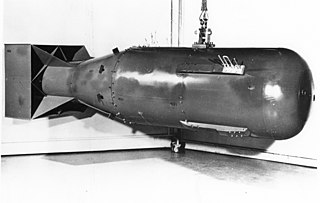 W
WA nuclear weapon is an explosive device that derives its destructive force from nuclear reactions, either fission or from a combination of fission and fusion reactions. Both bomb types release large quantities of energy from relatively small amounts of matter.
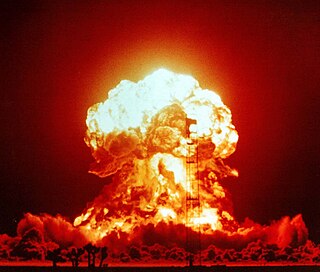 W
WNuclear weapons possess enormous destructive power from nuclear fission or combined fission and fusion reactions. Building on scientific breakthroughs made during the 1930s, the United States, the United Kingdom, Canada, and free France collaborated during World War II, in what was called the Manhattan Project, to build a fission weapon, also known as an atomic bomb. In August 1945, the atomic bombings of Hiroshima and Nagasaki were conducted by the United States against Japan at the close of that war, standing to date as the only use of nuclear weapons in hostilities. The Soviet Union started development shortly after with their own atomic bomb project, and not long after, both countries were developing even more powerful fusion weapons known as hydrogen bombs. Britain and France built their own systems in the 1950s, and the list of states with nuclear weapons has gradually grown larger in the decades since.
 W
WThis is a list of nuclear weapons listed according to country of origin, and then by type within the states.
 W
WEight sovereign states have publicly announced successful detonation of nuclear weapons. Five are considered to be nuclear-weapon states (NWS) under the terms of the Treaty on the Non-Proliferation of Nuclear Weapons (NPT). In order of acquisition of nuclear weapons these are the United States, the Soviet Union, the United Kingdom, France, and China.
 W
WNuclear weapons delivery is the technology and systems used to place a nuclear weapon at the position of detonation, on or near its target. Several methods have been developed to carry out this task.
 W
WThe 2010 Nuclear Security Summit was a summit held in Washington, D.C., on April 12 and 13, 2010. The Summit focused on how to better safeguard weapons-grade plutonium and uranium to prevent nuclear terrorism.
 W
WThe AGM-86 ALCM is an American subsonic air-launched cruise missile (ALCM) built by Boeing and operated by the United States Air Force. This missile was developed to increase the effectiveness and survivability of the Boeing B-52H Stratofortress strategic bomber. The missile dilutes an enemy's forces and complicates air defense of its territory.
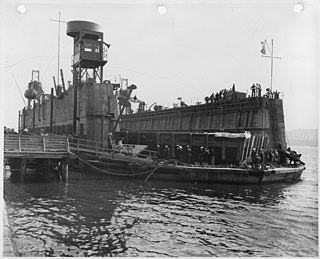 W
WThe ARDC-13 was a 2800-ton auxiliary floating drydock used for testing during the Able and Baker nuclear weapon tests of Operation Crossroads in the Bikini Atoll. It was used to determine the effects of the atomic bomb phenomena on land-based concrete structures. The final report on ARDC-13 was part of a final supplementary report to the Commander Joint Task Force One. The ARDC-13 was built by the Haddock Company out of Pasadena, California in March 1946 under contract Noy-11999. It was 84 feet by 389 feet with a depth of 14 feet. Two wingwalls, both 26 feet high and 306 feet long, were mounted on top of the ARDC-13. Steel frames were built within the wingwalls for extra support. The wingwalls consisted of transverse frames and both water and non-watertight bulkheads. The ARDC-13 was important for confirming that water-front structures needed to be designed to withstand severe waves and flooding as ports are considered a good target for bombs.
 W
WThe nuclear arms race was an arms race competition for supremacy in nuclear warfare between the United States, the Soviet Union, and their respective allies during the Cold War. During this same period, in addition to the American and Soviet nuclear stockpiles, other countries developed nuclear weapons, though none engaged in warhead production on nearly the same scale as the two superpowers.
 W
WNuclear artillery is a subset of limited-yield tactical nuclear weapons, in particular those weapons that are launched from the ground at battlefield targets. Nuclear artillery is commonly associated with shells delivered by a cannon, but in a technical sense short-range artillery rockets or tactical ballistic missiles are also included.
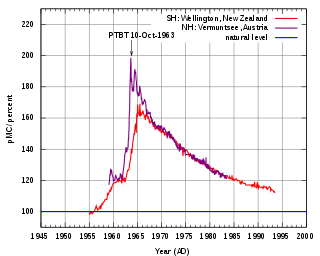 W
WThe bomb pulse is the sudden increase of carbon-14 (14C) in the Earth's atmosphere due to the hundreds of aboveground nuclear bombs tests that started in 1945 and intensified after 1950 until 1963, when the Limited Test Ban Treaty was signed by the United States, the Soviet Union and the United Kingdom. These hundreds of blasts were followed by a doubling of the relative concentration of 14C in the atmosphere. We discuss “relative concentration”, because measurements of 14C levels by mass spectrometers are most accurately made by comparison to another carbon isotope, often the common isotope 12C. Isotope abundance ratios are not only more easily measured, they are what 14C carbon daters want, since it is the fraction of carbon in a sample that is 14C, not the absolute concentration, that is of interest in dating measurements. The figure shows how the fraction of carbon in the atmosphere that is 14C, of order only a part per trillion, has changed over the past several decades following the bomb tests. Because 12C concentration has increased by about 30% over the past fifty years, the fact that “pMC”, measuring the isotope ratio, has returned (almost) to its 1955 value, means that 14C concentration in the atmosphere remains some 30% higher than it once was. Carbon-14, the radioisotope of carbon, is naturally developed in trace amounts in the atmosphere and it can be detected in all living organisms. Carbon of all types is continually used to form the molecules of the cells of organisms. Doubling of the concentration of 14C in the atmosphere is reflected in the tissues and cells of all organisms that lived around the period of nuclear testing. This property has many applications in the fields of biology and forensics.
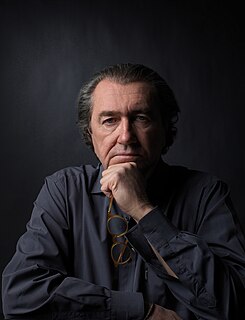 W
WBrian Dailey is an American artist noted for his careers in both art and international relations. His work in a variety of mediums—including photography, film, installations, and painting—engages with the social, political, and cultural issues of our times and is not easily categorized. Dailey's art reflects his unconventional evolution as an artist and multifaceted life experiences, which include national level involvement in arms control, space policy, intelligence systems, and international security. He is based in the Washington DC metropolitan area and maintains studios in the District and Woodstock, Virginia.
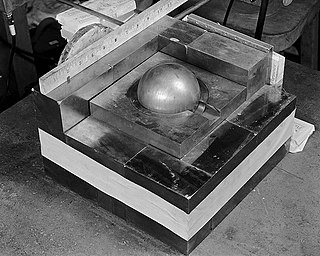 W
WThe demon core was a spherical 6.2-kilogram (14 lb) subcritical mass of plutonium 89 millimetres (3.5 in) in diameter, manufactured during World War II by the United States nuclear weapon development effort, the Manhattan Project, as a fissile core for an early atomic bomb. It was involved in two criticality accidents, on August 21, 1945, and May 21, 1946. The core was intended for use in a possible third nuclear weapon to be dropped on Japan, but when Japan's surrender made this unnecessary, it was used for testing. It was designed with a small safety margin to ensure a successful explosion of the bomb. The device briefly went supercritical when it was accidentally placed in supercritical configurations during two separate experiments intended to guarantee the core was close to the critical point. The incidents happened at the Los Alamos Laboratory, resulting in the acute radiation poisoning and subsequent deaths of scientists Harry Daghlian and Louis Slotin, respectively. After these incidents the spherical plutonium core was referred to as the "demon core".
 W
WNuclear weapon designs are physical, chemical, and engineering arrangements that cause the physics package of a nuclear weapon to detonate. There are three existing basic design types:pure fission weapons, the simplest and least technically demanding, were the first nuclear weapons built and have so far been the only type ever used in warfare. boosted fission weapons increase yield beyond that of the implosion design by using small quantities of fusion fuel to enhance the fission chain reaction. Boosting can more than double the weapon's fission energy yield. staged thermonuclear weapons are essentially arrangements of two or more "stages", most usually two. The first stage is normally a boosted fission weapon as above. Its detonation causes it to shine intensely with x-radiation, which illuminates and implodes the second stage filled with a large quantity of fusion fuel. This sets in motion a sequence of events which results in a thermonuclear, or fusion, burn. This process affords potential yields up to hundreds of times those of fission weapons.
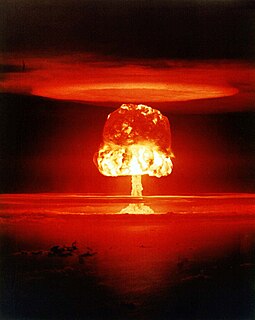 W
WA doomsday device is a hypothetical construction — usually a weapon or weapons system — which could destroy all life on a planet, particularly Earth, or destroy the planet itself, bringing "doomsday", a term used for the end of planet Earth. Most hypothetical constructions rely on hydrogen bombs being made arbitrarily large, assuming there are no concerns about delivering them to a target or that they can be "salted" with materials designed to create long-lasting and hazardous fallout.
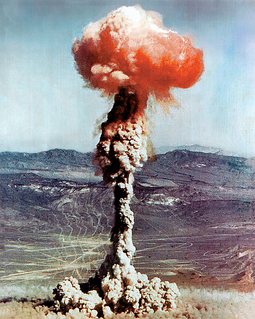 W
WThe effects of a nuclear explosion on its immediate vicinity are typically much more destructive and multifaceted than those caused by conventional explosives. In most cases, the energy released from a nuclear weapon detonated within the lower atmosphere can be approximately divided into four basic categories:the blast itself: 40–50% of total energy thermal radiation: 30–50% of total energy ionizing radiation: 5% of total energy residual radiation: 5–10% of total energy with the mass of the explosion.
 W
WThe medical effects of the atomic bomb on Hiroshima upon humans can be put into the four categories below, with the effects of larger thermonuclear weapons producing blast and thermal effects so large that there would be a negligible number of survivors close enough to the center of the blast who would experience prompt/acute radiation effects, which were observed after the 16 kiloton yield Hiroshima bomb, due to its relatively low yield:Initial stage—the first 1–9 weeks, in which are the greatest number of deaths, with 90% due to thermal injury and/or blast effects and 10% due to super-lethal radiation exposure. Intermediate stage—from 10–12 weeks. The deaths in this period are from ionizing radiation in the median lethal range - LD50 Late period—lasting from 13–20 weeks. This period has some improvement in survivors' condition. Delayed period—from 20+ weeks. Characterized by numerous complications, mostly related to healing of thermal and mechanical injuries, and if the individual was exposed to a few hundred to a thousand millisieverts of radiation, it is coupled with infertility, sub-fertility and blood disorders. Furthermore, ionizing radiation above a dose of around 50-100 millisievert exposure has been shown to statistically begin increasing a person's chance of dying of cancer sometime in their lifetime over the normal unexposed rate of c. 25%, in the long term, a heightened rate of cancer, proportional to the dose received, would begin to be observed after c. 5+ years, with lesser problems, such as eye cataracts, and other more minor effects in other organs and tissue also being observed over the long term.
 W
WElugelab, or Elugelap, was an island, part of the Enewetak Atoll in the Marshall Islands. It was destroyed by the world's first true hydrogen bomb test on 1 November 1952, a test which was codenamed shot "Mike" of Operation Ivy. Prior to being destroyed, the island was described as "just another small naked island of the atoll".
 W
WNuclear fallout is the residual radioactive material propelled into the upper atmosphere following a nuclear blast, so called because it "falls out" of the sky after the explosion and the shock wave has passed. It commonly refers to the radioactive dust and ash created when a nuclear weapon explodes. The amount and spread of fallout is a product of the size of the weapon and the altitude at which it is detonated. Fallout may get entrained with the products of a pyrocumulus cloud and fall as black rain. This radioactive dust, usually consisting of fission products mixed with bystanding atoms that are neutron-activated by exposure, is a form of radioactive contamination.
 W
WA fizzle occurs when the detonation of a device for creating a nuclear explosion grossly fails to meet its expected yield. The cause(s) for the failure can be linked to improper design, poor construction, or lack of expertise. All countries that have had a nuclear weapons testing program have experienced some fizzles. A fizzle can spread radioactive material throughout the surrounding area, involve a partial fission reaction of the fissile material, or both. For practical purposes, a fizzle can still have considerable explosive yield when compared to conventional weapons.
 W
WThe German nuclear weapons program was an unsuccessful scientific effort led by Germany to research and develop atomic weapons during World War II. It went through several phases of work, but in the words of a historian, it was ultimately "frozen at the laboratory level" with the "modest goal" to "build a nuclear reactor which could sustain a nuclear fission chain reaction for a significant amount of time and to achieve the complete separation of at least tiny amount of the uranium isotopes." Scholarly consensus is that it failed to achieve these goals.
 W
WChuck Hansen was the compiler, over a period of 30 years, of the world's largest private collection of unclassified documents on how America developed atomic and thermonuclear weapons.
 W
WThe HGV-202F is an Indian hypersonic glide vehicle (HGV) being designed, developed, and manufactured by an Indian Defence and Space company HTNP Industries.
 W
WThe Hwasong-16, or KN-27 under U.S. intelligence designations, is a new missile unveiled by North Korea on October 10, 2020, the 75th anniversary of the founding of the Workers' Party of Korea parade. This missile is seen as a new iteration of the Hwasong-15 and is another step along the path of North Korea's intercontinental ballistic missile (ICBM) program.
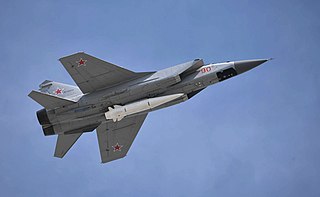 W
WThe Kh-47M2 Kinzhal ("dagger") is a Russian nuclear-capable air-launched ballistic missile (ALBM). It has a claimed range of more than 2,000 km (1,200 mi), Mach 10 speed, and an ability to perform evasive maneuvers at every stage of its flight. It can carry both conventional and nuclear warheads and can be launched from Tu-22M3 bombers or MiG-31K interceptors. It has been deployed at airbases in Russia's Southern Military District.
 W
WThe krytron is a cold-cathode gas-filled tube intended for use as a very high-speed switch, somewhat similar to the thyratron. It consists of a sealed glass tube with four electrodes. A small triggering pulse on the grid electrode switches the tube on, allowing a large current to flow between the cathode and anode electrodes. The vacuum version is called a vacuum krytron, or sprytron. The krytron was one of the earliest developments of the EG&G Corporation.
 W
WLaunch on warning (LOW) or fire on warning is a strategy of nuclear weapon retaliation that gained recognition during the Cold War between the Soviet Union and the United States. With the invention of intercontinental ballistic missiles (ICBMs), launch on warning became an integral part of mutually assured destruction (MAD) theory. Under the strategy, a retaliatory strike is launched upon warning of enemy nuclear attack while its missiles are still in the air and before detonation occurs. US land-based missiles can reportedly be launched within five minutes of a presidential decision to do so and submarine-based missiles within 15 minutes.
 W
WThe Maneuverable Reentry Vehicle is a type of ballistic missile whose warhead is capable of autonomously tracking ground targets. It often requires some terminal active homing guidance to make sure the missile does not miss the target, because of the frequent trajectory shifts. Refer to atmospheric reentry.
 W
WMetel Anti-Ship Complex is a Russian family of anti-submarine missiles. There are different anti-submarine variants ('Metel') for cruisers and frigates, and a later version with a shaped charge ('Rastrub') that can be used against shipping as well as submarines.
 W
WA mushroom cloud is a distinctive mushroom-shaped flammagenitus cloud of debris, smoke and usually condensed water vapor resulting from a large explosion. The effect is most commonly associated with a nuclear explosion, but any sufficiently energetic detonation or deflagration will produce the same effect. They can be caused by powerful conventional weapons, like thermobaric weapons, including the ATBIP and GBU-43/B Massive Ordnance Air Blast. Some volcanic eruptions and impact events can produce natural mushroom clouds.
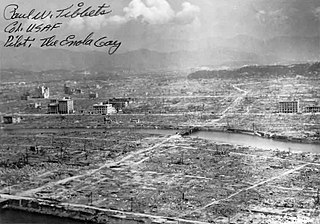 W
WMutual assured destruction (MAD) is a doctrine of military strategy and national security policy in which a full-scale use of nuclear weapons by two or more opposing sides would cause the complete annihilation of both the attacker and the defender. It is based on the theory of deterrence, which holds that the threat of using strong weapons against the enemy prevents the enemy's use of those same weapons. The strategy is a form of Nash equilibrium in which, once armed, neither side has any incentive to initiate a conflict or to disarm.
 W
WA nuclear depth bomb is the nuclear equivalent of the conventional depth charge, and can be used in anti-submarine warfare for attacking submerged submarines. The Royal Navy, Soviet Navy, and United States Navy had nuclear depth bombs in their arsenals at one point.
 W
WNuclear disarmament is the act of reducing or eliminating nuclear weapons. It can also be the end state of a nuclear-weapons-free world, in which nuclear weapons are completely eliminated. The term denuclearization is also used to describe the process leading to complete nuclear disarmament.
 W
WNuclear espionage is the purposeful giving of state secrets regarding nuclear weapons to other states without authorization (espionage). There have been many cases of known nuclear espionage throughout the history of nuclear weapons and many cases of suspected or alleged espionage. Because nuclear weapons are generally considered one of the most important of state secrets, all nations with nuclear weapons have strict restrictions against the giving of information relating to nuclear weapon design, stockpiles, delivery systems, and deployment. States are also limited in their ability to make public the information regarding nuclear weapons by non-proliferation agreements.
 W
WNuclear proliferation is the spread of nuclear weapons, fissionable material, and weapons-applicable nuclear technology and information to nations not recognized as "Nuclear Weapon States" by the Treaty on the Non-Proliferation of Nuclear Weapons, commonly known as the Non-Proliferation Treaty or NPT. Proliferation has been opposed by many nations with and without nuclear weapons, as governments fear that more countries with nuclear weapons will increase the possibility of nuclear warfare, de-stabilize international or regional relations, or infringe upon the national sovereignty of nation states.
 W
WNuclear safety is defined by the International Atomic Energy Agency (IAEA) as "The achievement of proper operating conditions, prevention of accidents or mitigation of accident consequences, resulting in protection of workers, the public and the environment from undue radiation hazards". The IAEA defines nuclear security as "The prevention and detection of and response to, theft, sabotage, unauthorized access, illegal transfer or other malicious acts involving nuclear material, other radioactive substances or their associated facilities".
 W
WThe Nuclear Suppliers Group (NSG) is a multilateral export control regime and a group of nuclear supplier countries that seek to prevent nuclear proliferation by controlling the export of materials, equipment and technology that can be used to manufacture nuclear weapons.
 W
WNuclear terrorism refers to any person or persons detonating a nuclear weapon as an act of terrorism. Some definitions of nuclear terrorism include the sabotage of a nuclear facility and/or the detonation of a radiological device, colloquially termed a dirty bomb, but consensus is lacking. In legal terms, nuclear terrorism is an offense committed if a person unlawfully and intentionally "uses in any way radioactive material … with the intent to cause death or serious bodily injury; or with the intent to cause substantial damage to property or to the environment; or with the intent to compel a natural or legal person, an international organization or a State to do or refrain from doing an act", according to the 2005 United Nations International Convention for the Suppression of Acts of Nuclear Terrorism.
 W
WNuclear warfare is a military conflict or political strategy which deploys nuclear weaponry. Nuclear weapons are weapons of mass destruction; in contrast to conventional warfare, nuclear warfare can produce destruction in a much shorter time and can have a long-lasting radiological result. A major nuclear exchange would have long-term effects, primarily from the fallout released, and could also lead to a "nuclear winter" that could last for decades, centuries, or even millennia after the initial attack. Some analysts dismiss the nuclear winter hypothesis, and calculate that even with nuclear weapon stockpiles at Cold War highs, although there would be billions of casualties, billions more rural people would nevertheless survive. However, others have argued that secondary effects of a nuclear holocaust, such as nuclear famine and societal collapse, would cause almost every human on Earth to starve to death.
 W
WNuclear winter is a severe and prolonged global climatic cooling effect that is hypothesized to occur after widespread firestorms following a large-scale nuclear war. The hypothesis is based on the fact that such fires can inject soot into the stratosphere, where it can block some direct sunlight from reaching the surface of the Earth. It is speculated that the resulting cooling would lead to widespread crop failure and famine. When developing computer models of nuclear-winter scenarios, researchers use the conventional bombing of Hamburg, and the Hiroshima firestorm in World War II as example cases where soot might have been injected into the stratosphere, alongside modern observations of natural, large-area wildfire-firestorms.
 W
WNUKEMAP is an interactive map using Mapbox API and declassified nuclear weapons effects data, created by Alex Wellerstein, a historian of science at the Stevens Institute of Technology who studies the history of nuclear weapons. The initial version was created in February 2012, with major upgrades in July 2013, which enables users to model the explosion of nuclear weapons on virtually any terrain and at virtually any altitude of their choice. A variation of the script, NUKEMAP3D, featured rough models of mushroom clouds in 3D, scaled to their appropriate sizes. NUKEMAP3D is no longer functional as Google deprecated the Google Earth plugin.
 W
WOn Thermonuclear War is a book by Herman Kahn, a military strategist at the RAND Corporation, although it was written only a year before he left RAND to form the Hudson Institute. It is a controversial treatise on the nature and theory of war in the thermonuclear weapon age. In it, Kahn addresses the strategic doctrines of nuclear war and its effect on the international balance of power.
 W
WA Permissive Action Link (PAL) is an access control security device for nuclear weapons. Its purpose is to prevent unauthorized arming or detonation of the nuclear weapon. The United States Department of Defense definition is:A device included in or attached to a nuclear weapon system to preclude arming and/or launching until the insertion of a prescribed discrete code or combination. It may include equipment and cabling external to the weapon or weapon system to activate components within the weapon or weapon system.
 W
WThe pit, named after the hard core found in fruits such as peaches and apricots, is the core of an implosion nuclear weapon – the fissile material and any neutron reflector or tamper bonded to it. Some weapons tested during the 1950s used pits made with U-235 alone, or in composite with plutonium, but all-plutonium pits are the smallest in diameter and have been the standard since the early 1960s.
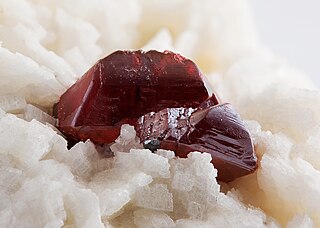 W
WRed mercury is purportedly a substance of uncertain composition used in the creation of nuclear weapons, as well as other weapons systems. Because of the great secrecy surrounding the development and manufacturing of nuclear weapons, there is no proof that red mercury exists. However, all samples of alleged "red mercury" analyzed in the public literature have proven to be well-known, common red substances of no interest to weapons makers.
 W
WStockpile stewardship refers to the United States program of reliability testing and maintenance of its nuclear weapons without the use of nuclear testing.
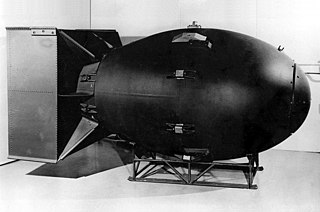 W
WA strategic nuclear weapon refers to a nuclear weapon that is designed to be used on targets often in settled territory far from the battlefield as part of a strategic plan, such as military bases, military command centers, arms industries, transportation, economic, and energy infrastructure, and heavily populated areas such as cities and towns, which often contain such targets. It is in contrast to a tactical nuclear weapon, which is designed for use in battle as part of an attack with and often near friendly conventional forces, possibly on contested friendly territory.
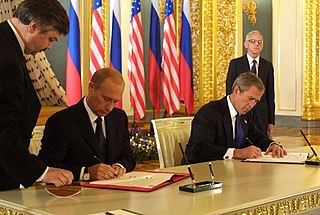 W
WThe Treaty Between the United States of America and the Russian Federation on Strategic Offensive Reductions (SORT), also known as the Treaty of Moscow, was a strategic arms reduction treaty between the United States and Russia that was in force from June 2003 until February 2011 when it was superseded by the New START treaty. At the time, SORT was positioned as "represent[ing] an important element of the new strategic relationship" between the two countries with both parties agreeing to limit their nuclear arsenal to between 1,700 and 2,200 operationally deployed warheads each. It was signed in Moscow on 24 May 2002. After ratification by the U.S. Senate and the State Duma, SORT came into force on 1 June 2003. It would have expired on 31 December 2012 if not superseded by New START. Either party could have withdrawn from the treaty upon giving three months written notice to the other.
Iran convened a conference titled "International Disarmament and Non-proliferation: World Security without Weapons of Mass Destruction" on 17 and 18 April 2010 in Tehran. The theme of the conference was Nuclear Energy for All, Nuclear Weapons for No One.
 W
WNuclear weapons tests are experiments carried out to determine the effectiveness, yield, and explosive capability of nuclear weapons. Testing nuclear weapons offers practical information about how the weapons function, as well as how detonations are affected by different conditions; and how personnel, structures, and equipment are affected when subjected to nuclear explosions. However, nuclear testing has often been used as an indicator of scientific and military strength, and many tests have been overtly political in their intention; most nuclear weapons states publicly declared their nuclear status by means of a nuclear test.
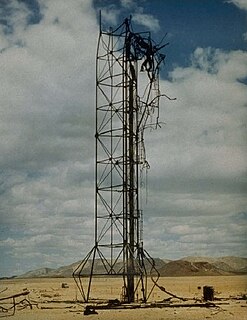 W
WThe uranium hydride bomb was a variant design of the atomic bomb first suggested by Robert Oppenheimer in 1939 and advocated and tested by Edward Teller. It used deuterium, an isotope of hydrogen, as a neutron moderator in a uranium-deuterium ceramic compact. Unlike all other fission-based weapon types, the concept relies on a chain reaction of slow nuclear fission. Bomb efficiency was adversely affected by the cooling of neutrons since the latter delays the reaction, as delineated by Rob Serber in his 1992 extension of the original Los Alamos Primer.
 W
WNuclear warfare is a military conflict or political strategy which deploys nuclear weaponry. Nuclear weapons are weapons of mass destruction; in contrast to conventional warfare, nuclear warfare can produce destruction in a much shorter time and can have a long-lasting radiological result. A major nuclear exchange would have long-term effects, primarily from the fallout released, and could also lead to a "nuclear winter" that could last for decades, centuries, or even millennia after the initial attack. Some analysts dismiss the nuclear winter hypothesis, and calculate that even with nuclear weapon stockpiles at Cold War highs, although there would be billions of casualties, billions more rural people would nevertheless survive. However, others have argued that secondary effects of a nuclear holocaust, such as nuclear famine and societal collapse, would cause almost every human on Earth to starve to death.
 W
WWeapons-grade nuclear material is any fissionable nuclear material that is pure enough to make a nuclear weapon or has properties that make it particularly suitable for nuclear weapons use. Plutonium and uranium in grades normally used in nuclear weapons are the most common examples.